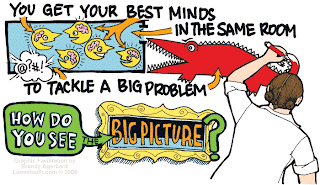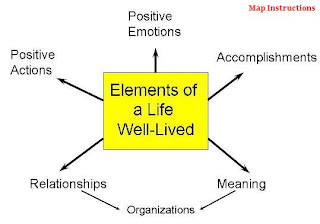On Visual Thinking
We think in pictures and words and we use both to communicate. We also tend to favour one cognitive style over the other, just as cultures do. Since the advent of the printing press, the written word has had the upper hand in western society, to mangle a metaphor. This is now changing rapidly.
Thanks to easy-to-use inexpensive computers, digital cameras, and high speed Internet, there’s been a profound upsurge in our society’s capacity to think and communicate visually. The following lists a few ways this is manifesting. As Dan Roam, The Back of the Napkin, observes: Drawing things out helps us look, see, imagine, and show ideas that would have remained hidden had we not picked up the pen.
Visual Thinking & Education
Thinking Through Stone
My own study of visual thinking began in earnest in the early 90s. For my doctoral fieldwork, I lived two years in a remote village in western Kenya. Tabaka is the epicenter of a century-old soapstone carving cottage industry. My research focused on how one generation of carvers transferred their visual knowledge to the next generation. Of course, this was largely non-verbal, indirect, and informal. It’s an interesting process to try to externalize a creative visual activity. There’s an entire literature and methodology on this subject. Vera John-Steiner’s Notebooks of the Mind is an exemplar.
Visual Spatial Learners
A significant number of students are visual spatial learners. Dr. Linda Kreger Silverman’s research and website are a tremendous resource. Slightly over half of all early school leavers have a visual spatial orientation. Dr. Silverman makes a powerful case that these young people could be and should be taught to their strengths. -
A computer is as indispensable to the visual-spatial child as a book is to an auditory-sequential child. It is visual, graphic, unconcerned with time, highly motivating, responsive to the inquisitive mind of the visual-spatial learner, and accesses the right hemisphere. It is the skating rink where a visual-spatial mind can perform dazzling feats ... Success in our technological era depends upon different skills than are currently emphasized in school: visualization, grasping the big picture, multi-dimensional perception, pattern finding, thinking graphically, and creativity.
New Innovation: Picturing To Learn
There’s a remarkable pilot program underway called Picturing To Learn through the aegis of Harvard and MIT. One of the co-founders, Felice Frankel, states that ‘visually explaining concepts can be a powerful learning tool.’ Part of the reason is that creating a picture can reveal connections that words alone may not. It fosters a holistic perspective and the ability to tell a complete story. When used to help high school students learn and express scientific concepts, the most amazing results occur. Ms. Frankel and her colleagues have already developed a database with more than 4000 drawings.
Visual Communication Tools
Paper & Pencil
We've been creating images to communicate from the start. The drawing featured below was created in Lascaux 17,000 years ago. How easily we can 'read it' today. The means to communicate visually are almost always at hand. What a profoundly simple and immediate way to convey so much at once.

Paper & Pencil
We've been creating images to communicate from the start. The drawing featured below was created in Lascaux 17,000 years ago. How easily we can 'read it' today. The means to communicate visually are almost always at hand. What a profoundly simple and immediate way to convey so much at once.

A mind map is a diagram used to represent words, ideas, tasks, or other items linked to and arranged radially around a central key word or idea. It is used to generate, visualize, structure, and classify ideas, and as an aid in study, organization, problem solving, decision making, and writing. There are many variations of this mapping process, for example Concept Maps and Semantic Maps. Each has its own centre of gravity, protocols, and practitioners. Mo st have software equivalents too.
Graphic Facilitation
Practitioners help groups better picture what they are thinking and trying to express to each other. They are skilled in literally drawing out the groups’ thoughts and feelings as they emerge through guided dialogue. The results can be very impressive. A graphic facilitator generally works with marking pens on a large (4-feet-high and 10-to-15-feet-long) sheets of butcher paper.
Image Maps
An image map is an online tool featuring one overall diagram with specific parts hyperlinked to relevant destinations. The example here is from the emerging field of Positive Psychology. As its creator’s note, these image maps can help people get a mental structure for storing information about positive psychology, and the attached articles form a reader’s guide for learning about the subject.
Interactive White Boards
This large interactive display enables an individual or group to write or draw on the surface, print off the image, save it to computer or distribute it over a network. Images can also be projected on the screen from a computer and worked on a life size scale, which in turn is recorded on the computer. SMART Technologies, a Canadian based producer of interactive whiteboards alone generates about a billion dollars in revenues.
Surface
Microsoft Surface is a 30-inch display in a table-like form factor that several people can use simultaneously. The intuitive user interface works without a traditional mouse or keyboard, allowing small groups to interact with visual content and information in a more natural and familiar way, by using their hands, gestures, and creativity.
Vision Boards
This is an interesting trend that takes the dynamics of visual thinking to another level. Vision Boards are just that, boards on which people draw or collage images of their goals and dreams. It is believe by practitioners that creating a vision board and using it as meditation will help their goals and dreams to materialize. As with practically every other tool, a community of practice and ecosystem of enterprise has evolved. There are software companies offering a streamlined online digital approach as well. I will revisit the related practices of visualization and imagineering in another post. Suffice it to say there’s extensive research underscoring the value of these processes.
An image map is an online tool featuring one overall diagram with specific parts hyperlinked to relevant destinations. The example here is from the emerging field of Positive Psychology. As its creator’s note, these image maps can help people get a mental structure for storing information about positive psychology, and the attached articles form a reader’s guide for learning about the subject.
Interactive White Boards
This large interactive display enables an individual or group to write or draw on the surface, print off the image, save it to computer or distribute it over a network. Images can also be projected on the screen from a computer and worked on a life size scale, which in turn is recorded on the computer. SMART Technologies, a Canadian based producer of interactive whiteboards alone generates about a billion dollars in revenues.
Surface
Microsoft Surface is a 30-inch display in a table-like form factor that several people can use simultaneously. The intuitive user interface works without a traditional mouse or keyboard, allowing small groups to interact with visual content and information in a more natural and familiar way, by using their hands, gestures, and creativity.
Vision Boards
This is an interesting trend that takes the dynamics of visual thinking to another level. Vision Boards are just that, boards on which people draw or collage images of their goals and dreams. It is believe by practitioners that creating a vision board and using it as meditation will help their goals and dreams to materialize. As with practically every other tool, a community of practice and ecosystem of enterprise has evolved. There are software companies offering a streamlined online digital approach as well. I will revisit the related practices of visualization and imagineering in another post. Suffice it to say there’s extensive research underscoring the value of these processes.















No comments:
Post a Comment